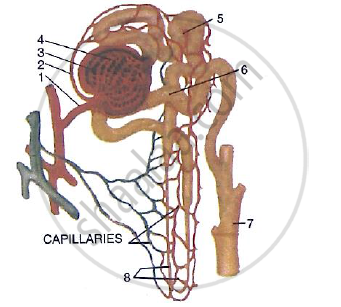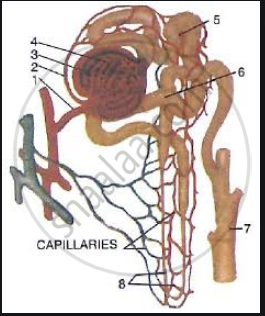Advertisements
Advertisements
प्रश्न
Describe the mechanism of urine formation in human excretory system. Draw a labelled diagram to illustrate your answer.
उत्तर
Kidneys are the main excretory organ of the human body. There are about millions of nephron in each kidney. Each nephron contains a renal corpuscle and a renal tubule. The renal corpuscle consists of capillaries called the glomerulus, enclosed by a capsule called Bowman's capsule. The blood containing wastes (like urea) enters the glomerulus. The glomerulus filters the blood. During filtration, the filtrate (containing substances like glucose, amino acids, salts, water and urea) present in the blood travels through the renal tubule where materials needed by the body are reabsorbed, while the wastes like urea are collected and excreted in the urine. The nephron carries the urine into the collecting tubule of the kidney from where it is carried to the ureter. From the ureter, the urine passes into the urinary bladder. The urinary bladder stores the urine until it is forced out of the body, through an opening known as the urethra.

APPEARS IN
संबंधित प्रश्न
The diagram given below shows the male urinogenital system of a human being. Study the diagram and answer the questions that follow:

(i) Label the parts numbered 1 to 8.
(ii) Name the corresponding structure of part (4) in female reproductive system.
(iii) What is the role of part 7?
Write the functions of Ureter
Name an animal which absorbs oxygen through its moist skin.
Where is urine carried through ureters?
Name the following:
The vein in which urea concentration is maximum
Differentiate between the following pairs of term :
Renal pelvis and renal papilla
Define the following term:
Micturition
The following diagram represents a mammalian kidney tubule (nephron) and its blood supply.

Parts indicated by the guidelines 1 to 8 are as follows:
1. Afferent arteriole from renal artery
2. efferent arteriole
3. Bowman’s capsule
4. Glomerulus;
5. Proximal convoluted tubule with blood capillaries;
6. Distal convoluted tubule with blood capillaries;
7. collecting tubule;
8. U-shaped loop of Henle
Study the diagram and answer the question that follow:
Where does ultrafiltration take place?
Explain in your own words with suitable examples.
How is excretion in plants useful to human beings?
The following diagram represents a mammalian kidney tubule (nephron) and its blood supply.

Parts indicated by the guidelines 1to 8 are as follows:
1. Afferent arteriole from renal artery
2. Efferent arteriole
3. Bowman's capsule
4. Glomerulus
5. Proximal convoluted tubule with blood capillaries
6. Distal convoluted tubule with blood capillaries
7. Collecting tubule
8. U-shaped loop of Henle
Study the diagram and answer the question that follow:
Which structure contains the lowest concentration of urea?
Describe in brief how urine is produced in the human body.
Explain the Term: Glomerulus
State the Location: Medulla of Kidney
Choose the Odd One Out:
Adult frog is an amphibian, its mode of excretion is ______.
The number of ATP molecules required to produce one molecule of urea from the omithine cycle.
“All plants give out oxygen during the day and carbon dioxide during the night”. Do you agree with this statement? Give a reason.
Give two examples of the following:
Bile pigments
Give reason:
Excretion is a necessary process of our body.
